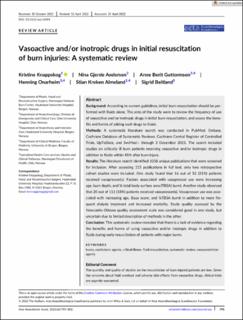| dc.contributor.author | Knappskog, Kristine | |
| dc.contributor.author | Andersen, Nina Gjerde | |
| dc.contributor.author | Guttormsen, Anne Berit | |
| dc.contributor.author | Onarheim, Henning | |
| dc.contributor.author | Almeland, Stian Kreken | |
| dc.contributor.author | Beitland, Sigrid | |
| dc.date.accessioned | 2022-09-27T11:58:47Z | |
| dc.date.available | 2022-09-27T11:58:47Z | |
| dc.date.created | 2022-09-15T13:15:37Z | |
| dc.date.issued | 2022 | |
| dc.identifier.issn | 0001-5172 | |
| dc.identifier.uri | https://hdl.handle.net/11250/3021780 | |
| dc.description.abstract | Background
According to current guidelines, initial burn resuscitation should be performed with fluids alone. The aims of the study were to review the frequency of use of vasoactive and/or inotropic drugs in initial burn resuscitation, and assess the benefits and harms of adding such drugs to fluids.
Methods
A systematic literature search was conducted in PubMed, Embase, Cochrane Database of Systematic Reviews, Cochrane Central Register of Controlled Trials, UpToDate, and SveMed+ through 3 December 2021. The search included studies on critically ill burn patients receiving vasoactive and/or inotropic drugs in addition to fluids within 48 h after burn injury.
Results
The literature search identified 1058 unique publications that were screened for inclusion. After assessing 115 publications in full text, only two retrospective cohort studies were included. One study found that 16 out of 52 (31%) patients received vasopressor(s). Factors associated with vasopressor use were increasing age, burn depth, and % total body surface area (TBSA) burnt. Another study observed that 20 out of 111 (18%) patients received vasopressor(s). Vasopressor use was associated with increasing age, Baux score, and %TBSA burnt in addition to more frequent dialysis treatment and increased mortality. Study quality assessed by the Newcastle-Ottawa quality assessment scale was considered good in one study, but uncertain due to limited description of methods in the other.
Conclusion
This systematic review revealed that there is a lack of evidence regarding the benefits and harms of using vasoactive and/or inotropic drugs in addition to fluids during early resuscitation of patients with major burns. | en_US |
| dc.language.iso | eng | en_US |
| dc.publisher | Wiley | en_US |
| dc.rights | Navngivelse 4.0 Internasjonal | * |
| dc.rights.uri | http://creativecommons.org/licenses/by/4.0/deed.no | * |
| dc.title | Vasoactive and/or inotropic drugs in initial resuscitation of burn injuries: A systematic review | en_US |
| dc.type | Journal article | en_US |
| dc.type | Peer reviewed | en_US |
| dc.description.version | publishedVersion | en_US |
| dc.rights.holder | Copyright 2022 The Authors | en_US |
| cristin.ispublished | true | |
| cristin.fulltext | original | |
| cristin.qualitycode | 1 | |
| dc.identifier.doi | 10.1111/aas.14095 | |
| dc.identifier.cristin | 2052047 | |
| dc.source.journal | Acta Anaesthesiologica Scandinavica | en_US |
| dc.source.pagenumber | 795-802 | en_US |
| dc.identifier.citation | Acta Anaesthesiologica Scandinavica. 2022, 66 (7), 795-802. | en_US |
| dc.source.volume | 66 | en_US |
| dc.source.issue | 7 | en_US |

